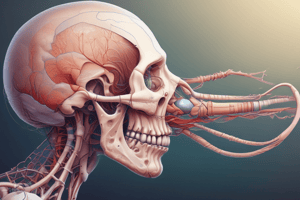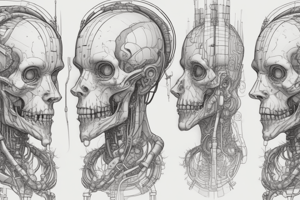Podcast
Questions and Answers
What is the stage of embryonic development characterized by a compact, spherical cluster of cells?
What is the stage of embryonic development characterized by a compact, spherical cluster of cells?
- Neurulation
- Gastrula
- Blastula
- Morula (correct)
Which germ layer gives rise to the skin and nervous system?
Which germ layer gives rise to the skin and nervous system?
- Endoderm
- Mesoderm
- Blastocoel
- Ectoderm (correct)
During which stage does the neural tube form from the ectoderm?
During which stage does the neural tube form from the ectoderm?
- Somitogenesis
- Gastrula
- Neurulation (correct)
- Morula
What is the name of the cavity that forms in the blastula stage?
What is the name of the cavity that forms in the blastula stage?
During which stage do the three primary germ layers differentiate into specific organs and organ systems?
During which stage do the three primary germ layers differentiate into specific organs and organ systems?
What is the purpose of the umbilical cord in fetal development?
What is the purpose of the umbilical cord in fetal development?
Flashcards are hidden until you start studying
Study Notes
Stages of Embryonic Development
- Morula (days 3-4): A compact, spherical cluster of cells formed through several divisions of the zygote.
- Blastula (days 4-5): A fluid-filled cavity called a blastocoel forms, surrounded by an outer layer of cells (trophectoderm) and an inner cell mass (embryoblast).
- Gastrula (days 5-7): The embryo undergoes gastrulation, where the blastula invaginates to form three primary germ layers:
- Ectoderm: Gives rise to skin, nervous system, and sensory organs.
- Mesoderm: Forms muscles, bones, cartilage, and connective tissue.
- Endoderm: Develops into lining of digestive system, respiratory tract, and other internal organs.
Organogenesis
- Neurulation (weeks 3-4): The neural tube forms from the ectoderm, eventually giving rise to the central nervous system (brain and spinal cord).
- Somitogenesis (weeks 3-4): The paraxial mesoderm differentiates into somites, which will form muscles, bones, and connective tissue.
- Organ formation (weeks 4-8): The three primary germ layers differentiate into specific organs and organ systems.
Fetal Development
- Fetal period (weeks 9-38): The embryo is now called a fetus, and rapid growth and organ maturation occur.
- Fetal circulation: The fetus receives oxygen and nutrients from the placenta, and waste products are removed through the umbilical cord.
Embryonic Development Abnormalities
- Teratogens: External factors (e.g., chemicals, radiation, viruses) that can cause birth defects.
- Congenital anomalies: Abnormalities present at birth, such as neural tube defects or limb deformities.
Studying That Suits You
Use AI to generate personalized quizzes and flashcards to suit your learning preferences.




